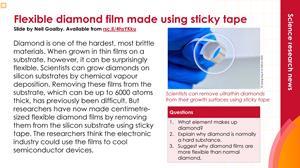Scientists discover new method for producing ultraflexible diamond films on an industrial scale
-

Download this
Use this story and the accompanying summary slide for a real-world context when studying diamonds and other carbon allotropes with your 14–16 learners.
Download the story as MS Word or PDF and the summary slide as MS PowerPoint or PDF.

Sticky tape is the secret ingredient to the recipe for ultrathin, flexible diamond films, report researchers in Hong Kong.
Zhiqin Chu, a professor at Hong Kong University, was inspired to use sticky tape to remove diamond films from silicon surfaces by the single-layer graphene discovery story. Konstantin, also known as Kostya, Novoselov and Andre Geim won the 2010 Nobel prize in physics for demonstrating that you can strip a single layer of graphene from graphite (the material in pencil leads) using sticky tape.
Zhiqin Chu, a professor at Hong Kong University, was inspired to use sticky tape to remove diamond films from silicon surfaces by the single-layer graphene discovery story. Konstantin Novoselov and Andre Geim won the 2010 Nobel prize in physics for demonstrating that you can strip a single layer of graphene from graphite (the material in pencil leads) using sticky tape.
Using the same sticky tape method, Zhiqin’s team produced circular diamond films approximately five centimetres in diameter. The films were less than one micrometre thick and ultraflexible. The scientists report that this technique is suitable for industrial scale manufacturing of diamond films.
Potential uses for these films include heat sinks in the electronics industry. Miniaturising electronics needs the continued development of materials that can better dissipate heat.
While diamond is among the hardest and most brittle materials on Earth, these thin diamond films are surprisingly flexible. Growing diamond films on silicon surfaces has been possible for a number of years, but removing them without damage has proven difficult, especially for films with a large surface area.
This article is adapted from Tim Wogan’s in Chemistry World.
Nina Notman
Reference
J Jing et al, Nature, 2024, 636, 627–634 (doi.org/10.1038/s41586-024-08218-x)
Download this
Summary slide with questions and the article for context when teaching 14–16 lessons on diamonds and other carbon allotropes: rsc.li/3CQZErZ
Downloads
Diamond film summary slide
PDF, Size 0.2 mbDiamond film summary slide
PowerPoint, Size 0.61 mbDiamond film student sheet
PDF, Size 0.16 mbDiamond film student sheet
Word, Size 0.51 mb















No comments yet